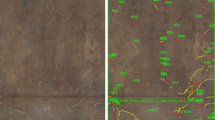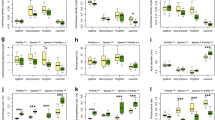Summary
Stable carbon isotope analysis was evaluated as a means of predicting the relative proportions of C3 and C4 root phytomass in species mixtures. The following mixtures of C3 and C4 species were used: 1) big bluestem (Andropogon gerardii)/cheatgrass (Bromus tectorum), 2) little bluestem (Schizachyrium scoparium)/cheatgrass, and 3) sorghum (Sorghum bicolor)/sunflower (Helianthus annuus). There was a significant correlation (P<0.01) between % C4 phytomass and stable carbon isotope values for each of the three combinations (r 2>0.98). Root length per mass varied among the five species studied (10.1–94.3 m/g), which resulted in different conclusions depending on whether root values are expressed as length or mass. For example, field samples from a tallgrass prairie site were estimated to contain about 20% cheatgrass on a mass basis, whereas the figure was 68% when expressed in terms of length. The combination of stable carbon isotope analysis with length-for-mass measurements promises to be a useful means of studying root competition between C3 and C4 plants.
Similar content being viewed by others
References
Bender M, Berge A (1979) Influence of N and K fertilization and growth temperature on 13C/12C ratios of Timothy (Phleum pratense L.). Oecologia (Berlin) 44:117–118
Bohm W (1979) Methods of studying root systems. New York: Springer
Bookman PA, Mack RN (1982) Root interactions between Bromus tectorum and Poa pratensis: a three-dimensional analysis. Ecology 63:640–646
Boutton TW, Arshad MA, Tieszen LL (1983a) Stable isotope analysis of termite food habits in East African grassland. Oecologia (Berlin) 59:1–6
Boutton TW, Smith BN, Harrison AT (1980) Carbon isotope ratios and crop analyses of Arphia (Orthoptera: Acrididae) species in southeastern Wyoming grassland. Oecologia (Berlin) 45: 299–306
Boutton TW, Wong WW, Hachey DL, Lee LS, Cabrera MP, Klein PD (1983b) Comparison of quartz and pyrex tubes for combustion of organic samples for stable carbon isotope analysis. Anal Chem 55:1832–1833
Chapin FS III, Slack M (1979) Effect of defoliation upon root growth, phosphate absorption and respiration in nutrient-limited tundra graminoids. Oecologia (Berlin) 42:67–79
Craig H (1957) Isotopic standards for carbon and oxygen and correction factors for mass spectrometric analysis of carbon dioxide. Geochim Cosmochim Acta 12:133–149
Fitter AH, Hay RKM (1981) Environmental physiology of plants. Academic Press, New York
Gregory PJ, McGowan M, Biscoe PV, Hunter B (1978) Water relations of winter wheat 1. Growth of the root system. J Agric Sci 91:91–102
Holm LG, Plucknett DL, Pancho JV, Herberger JP (1977) The world's worst weeds. Distribution and biology. Honolulu, Hawaii: University Press
Jones RJ, Ludlow MM, Troughton JH, Blunt CG (1979) Estimation of the proportion of C3 and C4 plant species in the diet of animals from the ratio of natural 12C and 13C isotopes in the faeces. J Agric Sci 92:91–100
Kummerow J (1980) Adaptation of roots in water-stressed native vegetation. In: Turner NC, Kramer PJ (eds) Adaptation of plants to water and high temperature stress. New York: John Wiley and Sons, pp 57–73
Lorenz RJ (1977) Changes in root weight and distribution in response to fertilization and harvest treatment of mixed prairie. In: Marshall JK (ed) The belowground ecosystem: a synthesis of plant-associated processes. Range Sci Dept Sci Series No 26. Colo State Univ, Ft Collins, pp 63–72
Lowdon JA, Dyck W (1974) Seasonal variations in the isotope ratios of carbon in maple leaves and other plants. Can J Earth Sci 11:79–88
Ludlow MM, Troughton JH, Jones RJ (1976) A technique for determining the proportion of C3 and C4 species in plant samples using stable natural isotopes of carbon. J Agric Sci 87:625–632
Newman EI (1966) A method of estimating the total length of root in a sample. J Appl Ecol 3:139–145
Nielsen NE, Barber SA (1978) Differences among genotypes of corn in the kinetics of P uptake. Agron J 70:695–698
O'Leary M (1981) Carbon isotope fractionation in plants. Phytochemistry 20:553–567
Remison SV, Snaydon RW (1980) A comparison of root competition and shoot competition between, Dactylis glomerata and Holcus lanatus. Grass and Forage Sci 35:183–187
Schoeller DA, Klein PD (1979) A microprocessor controlled mass spectrometer for the fully automated purification and isotopic analysis of breath CO2. Biomed Mass Spectrom 6:350–355
Smith BN, Oliver J, McMillan C (1976) Influence of carbon source, oxygen concentration, light intensity, and temperature on 13C/12C ratios in plant tissues. Bot Gaz 137:99–104
Tieszen LL, Hein D, Qvortrup SA, Troughton JH, Imbamba SK (1979) Use of δ13C values to determine vegetation selectivity in East African herbivores. Oecologia (Berlin) 37:351–359
Author information
Authors and Affiliations
Rights and permissions
About this article
Cite this article
Svejcar, T.J., Boutton, T.W. The use of stable carbon isotope analysis in rooting studies. Oecologia 67, 205–208 (1985). https://doi.org/10.1007/BF00384284
Received:
Issue Date:
DOI: https://doi.org/10.1007/BF00384284




